- The horizontal diffusion coefficients are based on the Smagorinsky (1963) formulation.
- The vertical diffusion is parameterized according to the Mellor and Yamada (1974) scheme, which employs a prognostic of the turbulent kinetic energy.
- The surface-atmosphere water, momentum and energy exchange are simulated by the Land Ecosystem Atmosphere Feedback model (LEAF-3), which represents the storage and vertical exchange of water and energy in multiple soil layers, including effects of freezing and thawing soil, temporary surface water or snowcover, vegetation, and canopy air (Walko et al., 2000).
- The advection scheme is a forwardupstream of second-order Tremback et al, (1987).
- Bulk microphysics (Walko et al., 2000)
- Convective cumulus scheme for deep and shallow convection based on Grell and Devenyi (2002).
- The 4D Data Assimilation (4DDA), a nudging type scheme in which the model fields can be nudged toward observational data assimulation progresses.

where adv, PBL turb and deep(shallow) conv stand for grid-scale advection, sub-grid transport in the planetary boundary layer (PBL) and sub-grid transport associated to moist and deep (shallow, non-precipitating) convection, respectively. W accounts for the convective wet removal for PM2.5, R is a sink term associated with generic process of removal/transformation of tracers (dry deposition and sedimentation for PM2.5 and chemical transformation for CO), and Qplume-rise is the source emission associated to the biomass burning process including the plume rise mechanism.
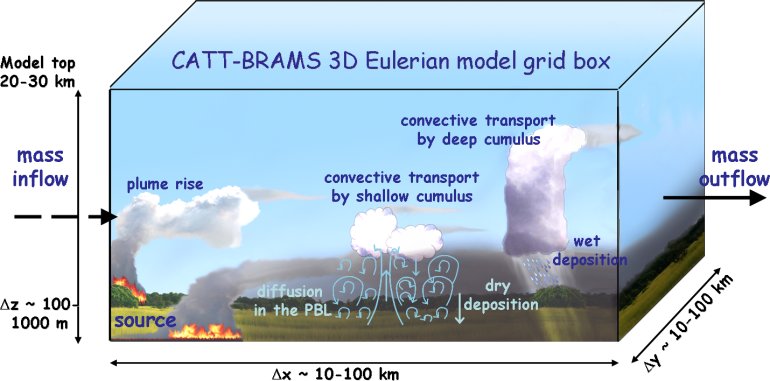
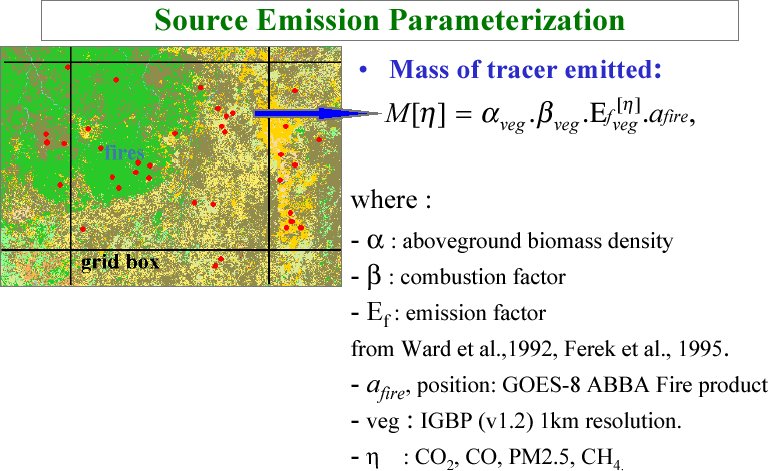 ) and its emission in the model
follows a diurnal cycle of the burning (emission rate
) and its emission in the model
follows a diurnal cycle of the burning (emission rate
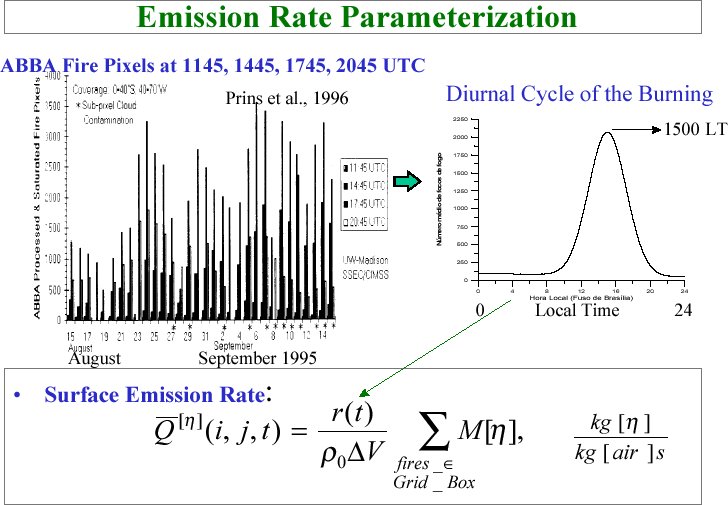 ). The type of
vegetation that is burning is obtained from the IGBP-INPE 1km vegetation
map (http://edcdaac.usgs.gov/glcc/glcc.html) and
(http://www.cptec.inpe.br/proveg/). The sources are spatially and
temporally distributed and daily assimilated according to the biomass
burning spots defined by the satellite observations (Figure 2). The
biomass burning emissions are added with the EDGAR agricultural waste
burn and fuelwood burning emissions with 1x1 degree horizontal
resolution and 1 year time resolution (see pictures
). The type of
vegetation that is burning is obtained from the IGBP-INPE 1km vegetation
map (http://edcdaac.usgs.gov/glcc/glcc.html) and
(http://www.cptec.inpe.br/proveg/). The sources are spatially and
temporally distributed and daily assimilated according to the biomass
burning spots defined by the satellite observations (Figure 2). The
biomass burning emissions are added with the EDGAR agricultural waste
burn and fuelwood burning emissions with 1x1 degree horizontal
resolution and 1 year time resolution (see pictures
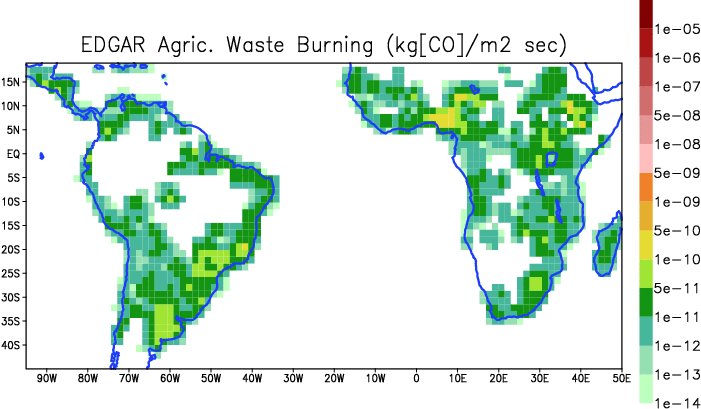
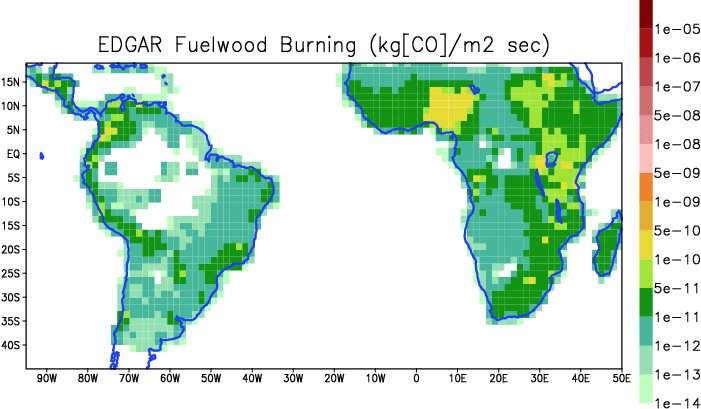 ). On African
continent, the biomass burning emissions are defined always following
the GFEDv2 prescription.
). On African
continent, the biomass burning emissions are defined always following
the GFEDv2 prescription.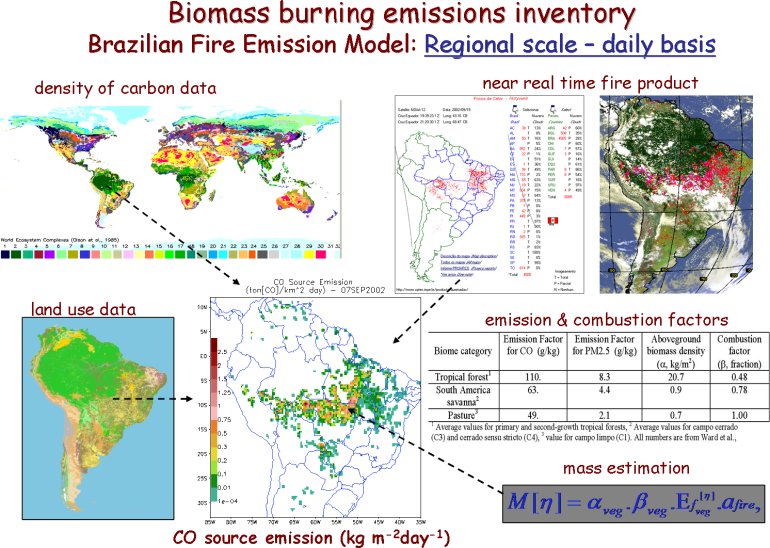
Figure 2. Biomass burning emissions inventory used by CATT-BRAMS model.
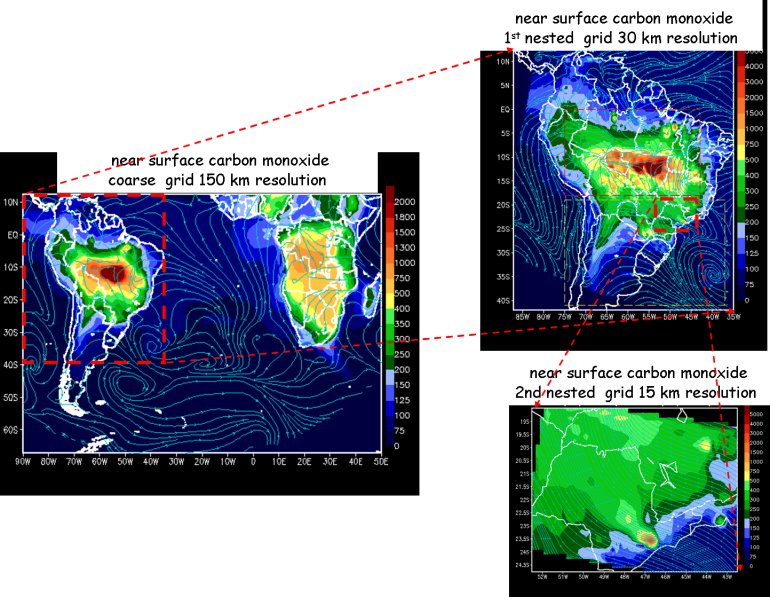
Figure 3. Operational model grids
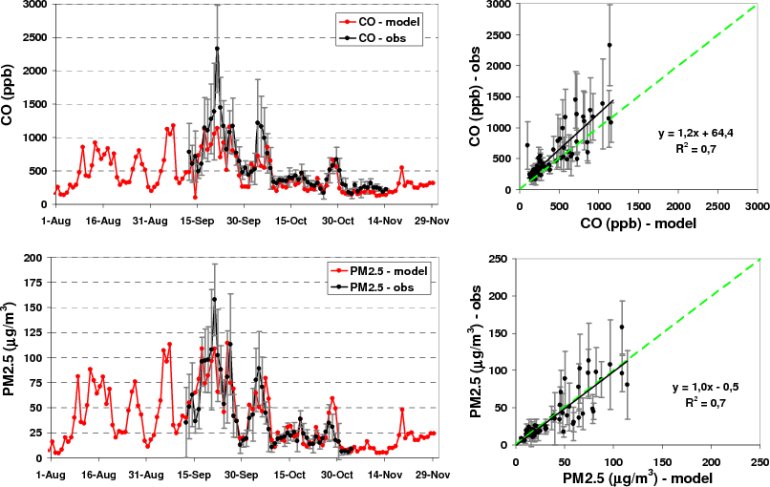
Figure 4. Time series with comparison between near surface CO (ppb, top) and PM2.5 (g m-3, bottom) observed (black) and model results (red). The measurements were daily averaged and centered at 1200 Z. The error bars are the standard deviations of the mean values. The model results are presented as instantaneous values at 1200 UTC.
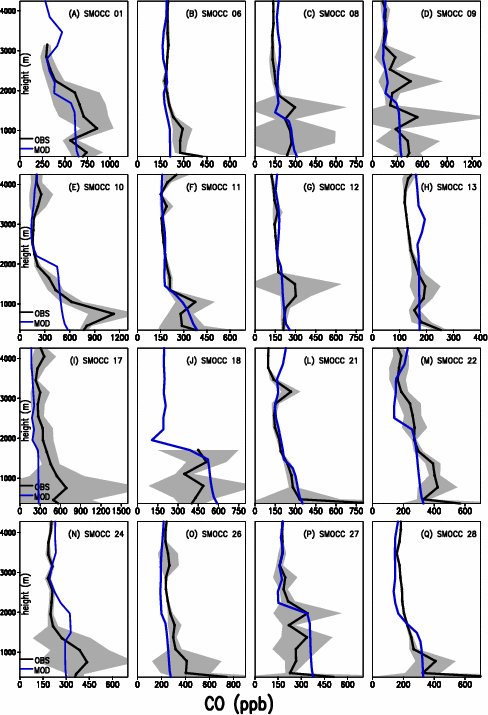
Figure 5. Comparison between CO (ppb) observed during sixteen flights of the LBA-SMOCC/RaCCI field campaign (black solid line represents the mean while the grey zone shows the standard deviation range) and model results (blue).
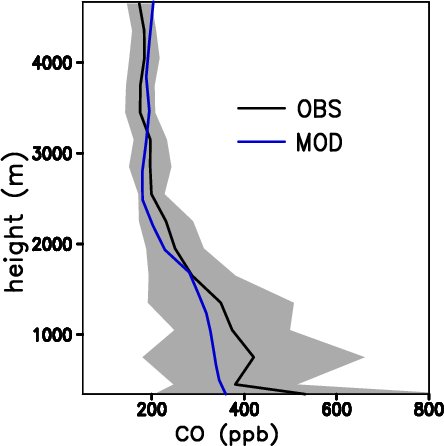
Figure 6. Comparison between the mean CO (ppb) observed during sixteen flights of the LBA-SMOCC/RaCCI field campaign (black solid line represents the mean while the grey zone shows the standard deviation range) and the mean of model results (blue).
 ,
,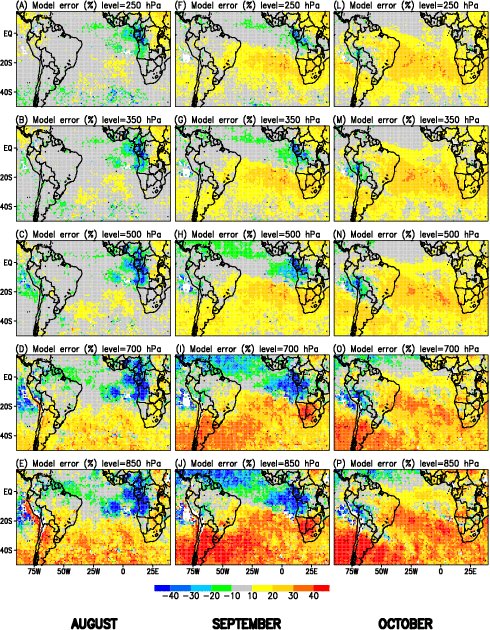
Figure 7. CO model relative error (%) relative to the MOPITT CO retrieval for the months August, September and October 2002 at five vertical levels (850, 700, 500, 350 and 250 hPa). Positive values mean that model results are underestimated in reference to the MOPITT retrieved data and vice-versa.
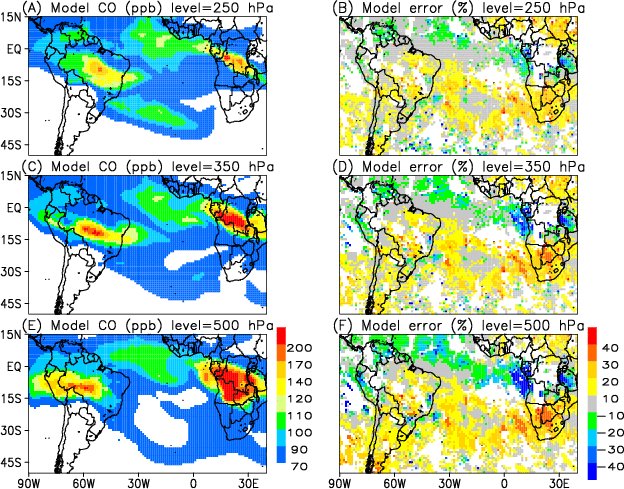
Figure 8. Model CO mixing ratio (ppb, on the left) and the model error relative to the MOPITT CO retrievals (%, on the right) at 250, 350 and 500 hPa. Model and MOPITT data were time averaged over the days 6, 7, 8 and 9 September 2002. White areas, on the right, denote places without valid data for MOPITT during the time average period.
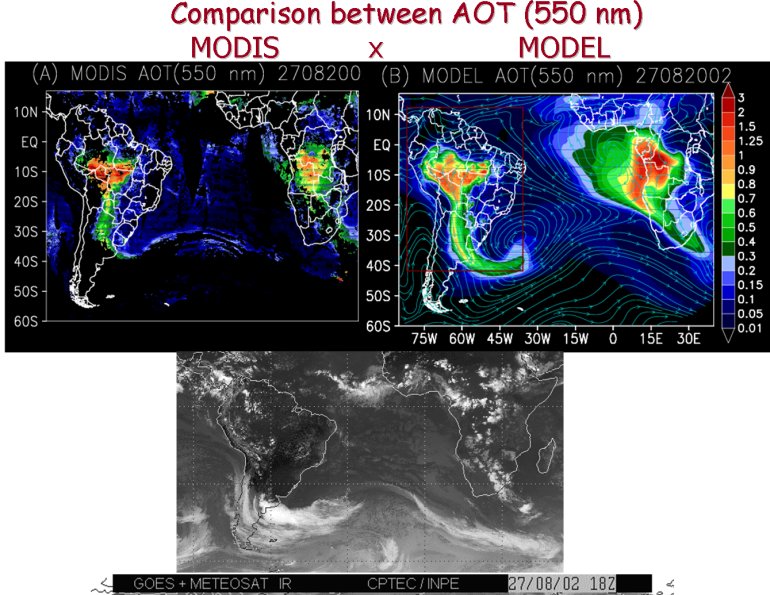
Figure 9. Model and MODIS AOT (550 nm) comparison.

Deeter, M. N., Emmons, L. K., Francis, G. L., Edwards, D. P., Gille, J. C., Warner, J. X., Khattatov, B., Ziskin, D., Lamarque, J.-F., Ho, S.-P., Yudin, V., Atti� J.-L., Packman, D., Chen, J., Mao, D., Drummond, J. R.: Operational carbon monoxide retrieval algorithm and selected results for the MOPITT instrument, J. Geophys. Res., 108(D14), 4399, doi:10.1029/2002JD003186, 2003.
Freitas, S. R., K. Longo, M. Silva Dias, P. Silva Dias. Emiss�s de queimadas em ecossistemas da Am�ica do Sul. Estudos Avan�dos 19 (53), p.167-185. ISSN 0103-4014, 2005.
Freitas, S. R., K. Longo, M. Silva Dias, P. Silva Dias, R. Chatfield, E. Prins, P. Artaxo, G. Grell and F. Recuero. Monitoring the transport of biomass burning emissions in South America. Environmental Fluid Mechanics, DOI:10.1007/s10652-005-0243-7, 5 (1-2), p. 135 167, 2005.
Freitas, S. R., Longo, K. M., and Andreae, M. O.: Impact of including the plume rise of vegetation fires in numerical simulations of associated atmospheric pollutants, Geophys. Res. Lett., 33, L17808, doi:10.1029/2006GL026608, 2006.
Freitas, S. R., K. Longo, M. Dias, R. Chatfield, P. Dias, P. Artaxo, M. Andreae, G. Grell, L. Rodrigues, A. Fazenda and J. Panetta.: The Coupled Aerosol and Tracer Transport model to the Brazilian developments on the Regional Atmospheric Modeling System (CATT-BRAMS). Part 1: Model description and evaluation. Atmos. Chem. Phys. Discuss., 7., 8525-8569, 2007.
Gevaerd, R., and Freitas, S. R.: Estimativa operacional da umidade do solo para inicia�o de modelos de previs� num�ica da atmosfera. Parte I: Descri�o da metodologia e valida�o, Revista Brasileira de Meteorologia, 21, 3, 1-15, 2006.
Grell, G. A., and Dezso Devenyi. A generalized approach to parameterizing convection combining ensemble and data assimilation techniques. Geophysical Research Letters, VOL. 29, NO. 14, 2002.
Longo, K. M.; Freitas, S. R.; Silva Dias, M.A.F. Dias, P. Silva Dias. Numerical modeling developments towards a system suitable to a real time air quality forecast and climate changes studies in South America. Newsletter of the International Global Atmospheric Chemistry Project, Taiwan, v. 33, p. 12-16, 2006.
Longo, K., S. R Freitas, A. Setzer, E. Prins, P. Artaxo, and M. Andreae. The Coupled Aerosol and Tracer Transport model to the Brazilian developments on the Regional Atmospheric Modeling System (CATT-BRAMS). Part 2: Model sensitivity to the biomass burning inventories. Atmos. Chem. Phys. Discuss., 8571-8595, 2007.
Mellor, G.L., and T. Yamada, 1974: A hierarchy of turbulence closure models for planetary boundary layers. J. Atmos. Sci., 31, 1791-1806.
Prins, E. M., J. M. Feltz, W. P. Menzel and D. E. Ward. An Overview of GOES-8 Diurnal Fire and Smoke Results for SCAR-B and 1995 Fire Season in South America. J. Geophys. Res., 103, D24, 31821-31835, 1998.
Procopio, A. S., L. A. Remer, P. Artaxo, Y. J. Kaufman, B. N. Holben. Modeled spectral optical properties for smoke aerosols in Amaz�ia. Geo. Res. Letters, Vol. 30, N. 24, 2265, doi:10.1029/2003GL018063, 2003.
Smagorinsky, J., 1963: General circulation experiments with the primitive equations. Part I, The basic experiment. Mon. Wea. Rev., 91, 99-164.
Tremback, C.J., J. Powell, W.R. Cotton, and R.A. Pielke, 1987: The forward in time upstream advection scheme: Extension to higher orders. Mon. Wea. Rev., 115, 540-555.
Walko R., Band L., Baron J., Kittel F., Lammers R., Lee T., Ojima D., Pielke R., Taylor C., Tague C., Tremback C., Vidale P. Coupled Atmosphere-Biophysics-Hydrology Models for Environmental Modeling. J Appl Meteorol 39: (6) 931-944, 2000.
Ward, D. E., R. A. Susott, J. B. Kauman, R. E. Babbit, D. L. Cummings, B. Dias, B. N. Holben, Y. J. Kaufman, R. A. Rasmussen, A. W. Setzer. Smoke and Fire Characteristics for Cerrado and Deforestation Burns in Brazil: BASE-B Experiment. J. Geophys. Res., 97, D13, 14601-14619, 1992.